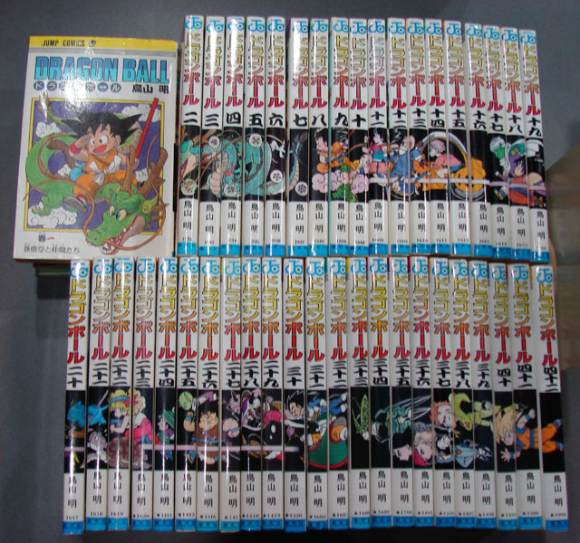
Is the landmark manga and starting point of the smash-hit anime losing its cultural relevancy?
With Dragon Ball’s status as one of Japan’s most successful and long-lived anime, manga, and video game series, you’d think just about everyone in the country would have read and enjoyed the Akira Toriyama comic that was the beginning of the multi-media franchise. But a recent poll shows that, at least in manga form, Dragon Ball isn’t attracting nearly as many young fans as it did in its heyday.
The Dragon Ball manga ran from 1984 to 1995, meaning that it ended before roughly half of Japan’s current college students were even born. To see what kind of cultural impact, if any, the manga has on them, Internet portal My Navi no Madoguchi conducted a survey of 403 college students, both male and female, asking them “Have you read Dragon Ball?”
Unfortunately, the vague wording of the question somewhat muddies the results, as it doesn’t specify if the subjects should respond with “yes” or “no” if you’ve read some, but not all, of the manga’s 519 chapters. Still, when left to their own judgement as to whether or not they’ve “read Dragon Ball,” only 64 respondents, or 15.9 percent of the pool, said that they had.
Among the remaining 84.1 percent who said they haven’t, explanations included:
“I don’t feel like getting into such a long series.”
“I read up until the middle of the story, but then I stopped buying the collected volumes.”
“I’m not interested in it because it’s old.”
“I’ve already seen the anime, so I’ve never read the manga.”
These are all valid complaints. Especially for modern otaku who are used to compact, 13-episode anime TV series, the commitment required by a story with hundreds of chapters can be intimidating and unappealing.
▼ The complete collection of Dragon Ball manga
And while Toriyama’s art is instantly recognizable and was hugely influential during Dragon Ball’s manga serialization, its thick lines and bulkily built heroes are definitely part of an aesthetic that manga and anime have largely moved on from.
The fact that Dragon Ball is both an anime and a manga, though, cuts both ways. Among those who have read the manga, many said they got into it after enjoying the series’ animated installments and licensed video games. Other reasons included:
“I wanted to check it out because it’s a famous series.”
“When I was a kid, my older brother was into it and we read it together.”
“They have the whole series at the barber shop I go to, so I read it when I went in for haircuts.”
Moreover, those who replied that they have read the manga gave it glowing reviews. So while Dragon Ball may not be the sort of society-wide shared pop cultural experience it was in the early ‘90s, with the potential synergy of new anime TV episodes and games being produced to this day, its manga might be poised for a comeback in popularity.
Source: My Navi Gakusei no Madoguchi/Yahoo! Japan via Hachima Kiko
Top image: RocketNews24
Insert image: Rakuten Auction


 New Dragon Ball anime series announced, turns Goku and friends into babies【Video】
New Dragon Ball anime series announced, turns Goku and friends into babies【Video】 After 30 years, mother of Dragon Ball’s Goku finally set to appear in new comic chapter
After 30 years, mother of Dragon Ball’s Goku finally set to appear in new comic chapter Goku’s new adventures begin! Dragon Ball Super begins airing amidst huge anticipation from fans
Goku’s new adventures begin! Dragon Ball Super begins airing amidst huge anticipation from fans World’s first Dragon Ball Store announced, opens before end of year
World’s first Dragon Ball Store announced, opens before end of year We are all Son Goku in this heartwarming, nostalgic Dragon Ball Z Kakarot commercial
We are all Son Goku in this heartwarming, nostalgic Dragon Ball Z Kakarot commercial Hayao Miyazaki says Happy New Year to Studio Ghibli fans with new art for Year of the Horse
Hayao Miyazaki says Happy New Year to Studio Ghibli fans with new art for Year of the Horse We revisited Sweets Paradise after a decade to see if Japan’s dessert buffet still delivers
We revisited Sweets Paradise after a decade to see if Japan’s dessert buffet still delivers Starbucks Japan unveils new S’mores Frappuccino and latte for Christmas 2025
Starbucks Japan unveils new S’mores Frappuccino and latte for Christmas 2025 Studio Ghibli adds magic to your matcha with new tea ceremony whisk and bowl
Studio Ghibli adds magic to your matcha with new tea ceremony whisk and bowl Popular Japanese store Loft reveals their top 12 most popular items sold in 2018【Pictures】
Popular Japanese store Loft reveals their top 12 most popular items sold in 2018【Pictures】 Our batch of homemade Oreos – Why didn’t we think of this before?
Our batch of homemade Oreos – Why didn’t we think of this before? Dragon Quest Burgers and Slime drinks are coming to McDonald’s Japan【Video】
Dragon Quest Burgers and Slime drinks are coming to McDonald’s Japan【Video】 Winter walking event takes you around Totoro forest loved by Hayao Miyazaki
Winter walking event takes you around Totoro forest loved by Hayao Miyazaki How often do Japanese people rip silent farts? Survey investigates
How often do Japanese people rip silent farts? Survey investigates Studio Ghibli’s new desktop Howl’s Moving Castle will take your stationery on an adventure
Studio Ghibli’s new desktop Howl’s Moving Castle will take your stationery on an adventure Starbucks Japan ready to get Year of the Horse started with adorable drinkware and plushies【Pics】
Starbucks Japan ready to get Year of the Horse started with adorable drinkware and plushies【Pics】 Cyberpunk anime meets traditional culture in Ghost in the Shell gold leaf Japanese changing screens
Cyberpunk anime meets traditional culture in Ghost in the Shell gold leaf Japanese changing screens 7 great places to see Mt. Fuji from without having to climb it
7 great places to see Mt. Fuji from without having to climb it Hello Kitty Choco Egg figures are an adorable trip through three periods of Japanese pop culture【Pics】
Hello Kitty Choco Egg figures are an adorable trip through three periods of Japanese pop culture【Pics】 7-Eleven Japan’s ramen-cooking robot whipped us up a bowl of noodles【Taste test】
7-Eleven Japan’s ramen-cooking robot whipped us up a bowl of noodles【Taste test】 We found possibly the quietest Japanese-style hotel in Tokyo’s bustling Shinjuku district
We found possibly the quietest Japanese-style hotel in Tokyo’s bustling Shinjuku district Japan’s otoshidama tradition of giving kids money at New Year’s gets a social welfare upgrade
Japan’s otoshidama tradition of giving kids money at New Year’s gets a social welfare upgrade Sumo Sanrio! Hello Kitty and pals team up with Japan Sumo Association for new merch【Pics】
Sumo Sanrio! Hello Kitty and pals team up with Japan Sumo Association for new merch【Pics】 More Than a Capsule Stay: Why Solo Travelers Choose “global cabin Yokohama Chinatown”
More Than a Capsule Stay: Why Solo Travelers Choose “global cabin Yokohama Chinatown” Japan’s oldest largetooth sawfish in captivity back on display in Mie Prefecture
Japan’s oldest largetooth sawfish in captivity back on display in Mie Prefecture 7-Eleven Japan starts new temporary luggage storage service in over 300 branches
7-Eleven Japan starts new temporary luggage storage service in over 300 branches Disillusionment at Tsukiji’s tourist-target prices led us to a great ramen restaurant in Tokyo
Disillusionment at Tsukiji’s tourist-target prices led us to a great ramen restaurant in Tokyo Starbucks teams up with 166-year-old Kyoto doll maker for Year of the Horse decorations【Photos】
Starbucks teams up with 166-year-old Kyoto doll maker for Year of the Horse decorations【Photos】 Tokyo considering law requiring more trash cans following litter increase in heavily touristed area
Tokyo considering law requiring more trash cans following litter increase in heavily touristed area Tokyo’s Tsukiji sushi neighborhood asks tour groups to stay away for the rest of the month
Tokyo’s Tsukiji sushi neighborhood asks tour groups to stay away for the rest of the month Tokyo event lets you travel back in time, for free, to celebrate 100 years since Showa era start
Tokyo event lets you travel back in time, for free, to celebrate 100 years since Showa era start Sanrio theme park in Japan announces plans to expand into a Sanrio resort
Sanrio theme park in Japan announces plans to expand into a Sanrio resort Japan may add Japanese language proficiency, lifestyle classes to permanent foreign resident requirements
Japan may add Japanese language proficiency, lifestyle classes to permanent foreign resident requirements Stamina-destroying “Paralysis Noodles” are Tokyo’s newest over-the-top ramen innovation
Stamina-destroying “Paralysis Noodles” are Tokyo’s newest over-the-top ramen innovation Survey asks foreign tourists what bothered them in Japan, more than half gave same answer
Survey asks foreign tourists what bothered them in Japan, more than half gave same answer Japan’s human washing machines will go on sale to general public, demos to be held in Tokyo
Japan’s human washing machines will go on sale to general public, demos to be held in Tokyo Japan’s deadliest food claims more victims, but why do people keep eating it for New Year’s?
Japan’s deadliest food claims more victims, but why do people keep eating it for New Year’s? We deeply regret going into this tunnel on our walk in the mountains of Japan
We deeply regret going into this tunnel on our walk in the mountains of Japan Studio Ghibli releases Kodama forest spirits from Princess Mononoke to light up your home
Studio Ghibli releases Kodama forest spirits from Princess Mononoke to light up your home Major Japanese hotel chain says reservations via overseas booking sites may not be valid
Major Japanese hotel chain says reservations via overseas booking sites may not be valid Put sesame oil in your coffee? Japanese maker says it’s the best way to start your day【Taste test】
Put sesame oil in your coffee? Japanese maker says it’s the best way to start your day【Taste test】 No more using real katana for tourism activities, Japan’s National Police Agency says
No more using real katana for tourism activities, Japan’s National Police Agency says Starbucks Japan reveals new sakura drinkware collection, inspired by evening cherry blossoms
Starbucks Japan reveals new sakura drinkware collection, inspired by evening cherry blossoms Updated cherry blossom forecast shows extra-long sakura season for Japan this year
Updated cherry blossom forecast shows extra-long sakura season for Japan this year Vegeta to be the lead in a new Dragon Ball movie?!
Vegeta to be the lead in a new Dragon Ball movie?! He’ll be back! Goku to return to big screen in first-ever Dragon Ball Super anime film
He’ll be back! Goku to return to big screen in first-ever Dragon Ball Super anime film Before Dragon Ball: See the 1984 advertisements announcing the creation of this now classic manga
Before Dragon Ball: See the 1984 advertisements announcing the creation of this now classic manga Uniqlo announces new line of awesome Dragon Ball T-shirts and hoodies【Photos】
Uniqlo announces new line of awesome Dragon Ball T-shirts and hoodies【Photos】  Why the new Dragon Ball Daima anime is a perfect place for veteran fans to come back to the series
Why the new Dragon Ball Daima anime is a perfect place for veteran fans to come back to the series All-new Dragon Ball Super isn’t just an anime – manga adaptation coming too!
All-new Dragon Ball Super isn’t just an anime – manga adaptation coming too! Dragon Ball creator Akira Toriyama passes away
Dragon Ball creator Akira Toriyama passes away Why does Dragon Ball’s Goku get blond hair when he powers up? Editor reveals the secret
Why does Dragon Ball’s Goku get blond hair when he powers up? Editor reveals the secret We finally get to meet Goku’s mother — and we think she’s a real cutie!
We finally get to meet Goku’s mother — and we think she’s a real cutie! Latest Dragon Ball movie collaborates with explicit Japanese rock band
Latest Dragon Ball movie collaborates with explicit Japanese rock band Dragon Ball creator pulls a George Lucas, dispels the mysticism of Super Saiyan transformations
Dragon Ball creator pulls a George Lucas, dispels the mysticism of Super Saiyan transformations Dragon Ball characters appear in Ford anime ad specifically made for English-speakers 【Video】
Dragon Ball characters appear in Ford anime ad specifically made for English-speakers 【Video】 Awesome website allows you to make your own Dragon Ball character, battle other fighters
Awesome website allows you to make your own Dragon Ball character, battle other fighters
Leave a Reply